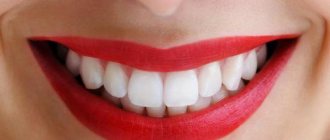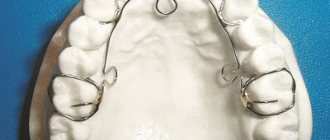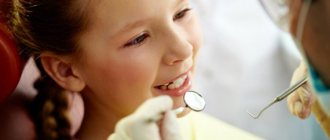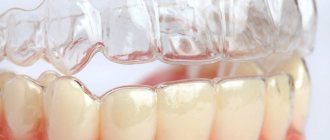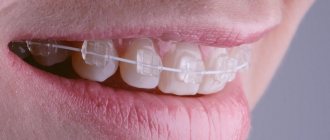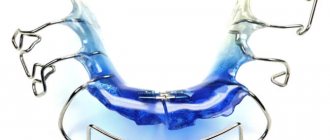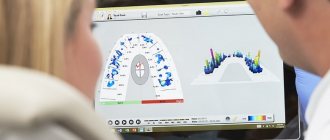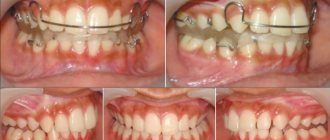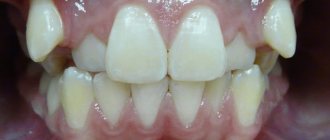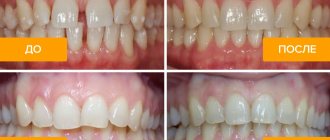Content:
- Differences between dental braces and braces
- Indications for use
- Contraindications
- Varieties
- Braces for children
- At what age is it best to use braces?
- How does the installation work?
- System care
When correcting malocclusion in adults and children, braces are often used. Compared to braces, they are removable, but you have to wear them longer. Visually, such leveling systems resemble wire arches running along the entire dentition.
Possibilities of night braces
Traditional braces are special non-removable mechanisms used in dental practice to correct bite defects. Treatment lasts from 1 to 2 years. The system is installed and dismantled by a doctor, who also monitors the course of the therapeutic course.
Removable structures are also used, which are often called “night braces.” These include:
- aligners (aligners);
- records;
- trainers.
The main feature of such systems, which distinguishes them from classic braces, is that they are not worn continuously. The patient can remove and install the mechanism himself as needed.
Example of night guards
Night guards or plates only cope with simple malocclusions. For this reason, they are most often used to treat children. When the dental rows have formed and the tissues have ossified, such products will not correct a serious disorder and will not provide a positive result of therapy.
The devices listed above are worn at night and for several hours during the day. Manufacturers offer a large selection of beautiful and different shaped systems. Children like these products. In addition, the devices are transparent, decorated with rhinestones, in one or several colors.
Colored plates for night correction of bite - an ideal solution for children
Corrective systems designed for night wear are:
- Unimaxillary . Fixed on one of the dentitions. Nowadays they are rarely used due to low efficiency.
- Double jawed . They are worn on both the upper and lower jaws. Develops a healthy bite in children. They are also used to wean the baby from some bad habits. We are talking, for example, about the habit of grinding teeth and biting nails.
Differences between dental braces and braces
The designs work on the same principle. Even translated from English, the word “brace,” from which the term “braces” comes, means “bracket.” But there are significant differences between them.
So, braces cannot be removed by yourself. They consist of a corrective arc and separate locks. When installing them on the dentition, special dental glue is used. Models are classical and lingual. The latter are located on the inside of the dentition, so they are invisible to others. Braces are expensive.
Staples are removable devices. They are a complete and very simple system. They are held on the teeth thanks to mechanical fixation using rings and clasps that fit onto dental crowns. Prices for dental braces are relatively low.
When should correction begin?
Elimination of occlusal defects in a child can and should begin with the eruption of baby teeth. Bone tissue in babies has not yet formed, so it is easily susceptible to any external influence. But during this period, braces are not used.
Let's consider when and how to correct the bite of children and adolescents:
- at 2-3 years, if necessary, treatment is carried out using special exercises for the facial muscles;
- at 5 years of age and older, removable orthodontic structures can be used for corrective therapy: trainers, plates and aligners;
- From 12-14 years old you can use braces. Their installation in children under 12 can only be performed for special medical reasons.
Not only age is the determining point in starting correctional therapy, but also the cumulative fulfillment of the following conditions:
- the completed process of tooth growth;
- the height of the coronal part is sufficient for fixing the bracket plates;
- strong enamel.
In any case, the possibility of installing a brace system is decided by the orthodontist in each specific situation after a visual and hardware examination.
Contraindications
Situations when staples cannot be installed may vary. Temporary contraindications include:
- Poor oral hygiene. Then you first need to carry out professional hygiene.
- Untreated caries. First you need to “close” all carious cavities.
- Progressive pulpitis, periodontitis, periodontal disease, gingivitis. Any dental ailments must be treated before bite correction begins.
- Individual intolerance to metal, acrylic. You need to choose a device that is made of hypoallergenic material.
Among the absolute contraindications to staple correction of malocclusion:
- pulmonary tuberculosis;
- tumor neoplasms (with and without metastases);
- diabetes;
- epilepsy, severe neurological disorders;
- AIDS, HIV;
- mental disorders.
Before making and fixing brackets on your teeth, you must undergo a diagnosis and dental examination. The doctor will tell you whether it is possible to correct the bite in this way and when it is best to do it. Typically, during diagnostic procedures, radiography or panoramic tomography of the jaw is performed.
Types of removable bracket systems
This is what teeth trainers look like
Night correction devices are divided into several types, as mentioned above. All varieties deserve detailed consideration.
- Mouthguards (“caps”, caps). Material – polymer or special metal that is resistant to oxidation. Mouthguards are manufactured using 3D computer modeling technology. They are performed individually for each patient, taking into account the characteristics of the dental anomaly. Initially, the doctor makes an impression of the dentition. The laboratory produces a whole set of mouthguards that differ slightly from each other. In the future, these caps will be used alternately to gradually move the dental units - strictly in the order indicated by the doctor. The period of operation of one “cap” is 14-20 days, after which it is replaced with the next cap.
- Records. Most often used in pediatric orthodontics. Promote the correct formation of dental rows and the healthy development of jaw bone tissue. The plates help expand the palate if necessary. They are made in different colors, according to a personal impression. They are attached to the teeth using thin wire hooks. You can remove the product yourself during meals or hygiene activities. If the plate is intended to align the dental line, then springs, loops and arches are mounted in it. If it is necessary to expand the jaw, then a special expanding screw is provided in the frame (installed between the two halves of the product).
- Trainers. Material: elastic silicone. Trainers have universal parameters. No correction is needed during the therapeutic process. The device is easily placed in the oral cavity and is very convenient to use. Eliminates excessive pressure of the tongue, labial muscles and cheeks on the dental rows. Thanks to this, teeth are positioned correctly, breathing and swallowing are normalized, muscle function and jaw bone growth are stabilized, and facial features are improved.
Varieties
Staples vary in scope, material of production, shape, and size. Each type has its own disadvantages and advantages, which affects the results of orthodontic treatment.
By area of application, staples are as follows:
- for correction of crooked bite;
- to return individual teeth to their place (it is possible to move units in relation to the horizontal and vertical plane, around their own axis);
- to eliminate crowding;
- to increase the volume of the palate.
If we talk about the method of fixation and the peculiarities of location in the oral cavity, then here are the corrective mechanisms:
- Lingual. Attached to the inner surface of the teeth. Visually similar to retainers. They treat malocclusion slowly, but do not spoil the smile. Such devices are chosen by public people, as well as people who tend to have complexes because of their own appearance.
- Vestibular. Placed in front of the teeth. They act faster than lingual ones, but change the smile for the worse. Quite large, which can cause problems with diction (especially in the first weeks of therapy).
Who should not wear trainers?
The systems described are primarily medical devices, so if you are impressed by the various photos before and after the trainer and want to buy such a device for yourself, be sure to consult with your doctor. Self-treatment with a trainer is dangerous and can cause harm.
There are other situations when it is better to choose another treatment option:
- if there is nasal congestion, which has become chronic (the patient simply will not be able to train at full strength, because he will have breathing problems);
- when the bite of the teeth in the lateral areas is cross;
- if a trainer is chosen for a child , but the child is uncontrollable and does not obey his parents (classes must be on schedule, otherwise there will be no effect).
In the described cases, it is better to use braces to correct a malocclusion.
Pros and cons of treatment with trainers
Why are dental trainers for adults and children so popular? This system has many advantages that make it popular and convenient. The main advantages of treatment using such structures:
- low price. The most budget trainer is very cheap, and modern improved models still cost 3-4 times less than an inexpensive brace system;
- ease of care. The patient does not require any special cleaning products or devices - just toothpaste and a brush are enough;
- versatility. The trainer does not need to be made specifically taking into account the patient’s characteristics; you just need to choose a model by size;
- wearing does not have a negative effect on the enamel or soft tissues, the devices do not injure the tongue or gums;
- In addition to bite, trainers also solve other problems, for example, correcting speech (in cases where diction problems were caused by incorrect dentition);
- the patient experiences minimal discomfort while wearing.
An additional advantage of trainer systems is that they do not cause any psychological discomfort: the trainer can be removed at any time to eat, drink or go to an important meeting. However, this method of changing the bite also has its disadvantages:
- slow effect. You need to wear the trainer for at least a year to see real results;
- prohibition on eating and drinking while wearing. If you take a trainer for a child , this can become a serious problem;
- Treatment must be carried out strictly according to schedule and for the required amount of time per day, otherwise there will be no effect. This option is only suitable for responsible people, and children should be supervised by parents.
Trainer effect: before and after
Braces for children
Pediatric dentists use such systems quite often. They are easy to install, quickly removed and work well in conditions where the bite is not fully formed.
Parents can tell that a child has dental problems by the following signs:
- the enamel has sharply darkened and thinned, the baby complains of pain when chewing food;
- the child sleeps poorly at night, often sucks his thumb in his sleep;
- difficulties arise with nasal breathing (it is replaced by breathing through the mouth);
- The size of some dental crowns has decreased.
All of these signs indicate that some area of the mouth is placing too much stress on the jaw. If orthodontic treatment is not carried out in time, the situation will worsen. At an older age, problems with permanent bite may occur.
Indications for installing braces
As in childhood, in adulthood the only indication for installing braces is malocclusion. This anomaly is characterized by the following symptoms:
- Noticeable crowding of teeth, their creeping onto each other.
- Gaps between teeth.
- Teeth tilted back or forward.
- Excessive protrusion of one of the jaws forward or backward.
- Large distance between the teeth of the upper and lower jaw.
- Shift of the jaws or dentition laterally relative to each other.
These problems can be either noticeable even to the naked eye or hidden. Sometimes, at first glance, it seems to a person that everything is fine with his bite, although in fact there is a violation. In this case, only a dentist can recognize them during a professional examination.
At what age is it best to use braces?
Dentists agree that these aligners are ideal for children between four and ten years of age. During this period there is active growth of the jaw.
During adolescence, braces are no longer as effective. If there is a pronounced curvature of the occlusion, you will have to use, at a minimum, plates, and better yet, braces. For adults, braces are placed for minor curvatures, as well as to prevent the return of the disease after using braces.
Why do you need to get braces?
Braces for an adult
Typically, braces are installed to improve your appearance. But sometimes malocclusions are almost invisible, so patients do not seek to correct them. But in fact, even a slight malocclusion can lead to serious consequences:
- Caries, gingivitis and other problems with teeth and gums due to uneven distribution of chewing load and injury to soft tissues from improperly growing teeth.
- Pain in the head and jaw due to improper positioning of teeth, compression of joints and nerves.
- Insufficient hygiene due to the fact that certain areas of the teeth cannot be approached due to other dental units.
- Rapid wear of individual teeth, abrasion and even loss.
- Digestive problems due to insufficient chewing of food.
- Inconvenience when using prosthetics in the future.
Therefore, even if there is no desire to make a smile beautiful, or if the bite does not spoil the appearance too much, treatment with braces is still necessary, since it is beneficial for health in the long term.
How does the installation work?
Fixation takes a little time. First, the dentist must carry out professional oral hygiene. During this procedure, an ultrasonic scaler is used, which quickly and atraumatically cleans crowns of soft plaque and hard stones.
The second stage is taking impressions. Based on them, plaster models are made.
The third step is trying on the finished system. The doctor selects the optimal degree of arch tension, then hands the device back to the dental technician.
The final stage is re-fitting and installation of the mechanism. The brackets are placed on the supporting molars using metal locks.
Afterwards, the patient immediately goes home and continues to lead his usual lifestyle. In the first three to seven days he will be plagued by unpleasant sensations. Saliva will begin to flow profusely. This is due to the body's attempts to remove the foreign body from the oral cavity. Pain in both jaws is also possible. It is explained by the fact that the bracket puts pressure on the teeth, causing them to shift.
How to put on and wear a trainer correctly. How long does it take to get used to
Adult and children's dental trainers are put on and worn the same way. Installing the device is quite simple:
- Place the device in your mouth so that the central stop is directed towards the upper palate. Next, find a position so that the stopper rests on the tip of the tongue and does not create discomfort.
- Move your lower jaw in different directions until the plates fit on the molars. Have you stopped slipping? You have achieved the desired result.
- Close your jaws with little force. You should feel pressure on all your teeth. You can touch the tip of the trainer with your tongue to feel if it fits correctly.
- Check if the trainer is positioned correctly: tighten your lips and take 3-4 deep breaths. If breathing is difficult, repeat the previous steps until it becomes easier.
Scheme for putting on the trainer
You need to wear the trainer for 1-4 hours during the day, as well as throughout the night. The regimen is determined by the doctor and must be followed. You can hold it for 30-40 minutes, but you cannot use the device less than necessary. If you need to remove the trainer, try to return it to its place as quickly as possible.
While wearing it, a person should not talk, eat or drink. If you are going to wear a trainer with your child, it is better to come up with entertainment for him during classes, for example, you can watch a cartoon or a movie, or draw. The habit of wearing a trainer develops over different periods of time – it all depends on the patient. At night, it is better to monitor the device regularly for at least a month (it may crash). During the day, the discomfort disappears in about a week, sometimes less.
Do not forget that while wearing a trainer, it is important to see a doctor once every two to three months. A visit to the orthodontist is a necessary procedure, because it allows you to determine the dynamics of changes in the dentition and correct the process in time if something goes wrong.
System care
A person can remove the staple from the oral cavity on their own, but this is not necessary. The device's locks are quite fragile. Without certain skills, they can be easily broken. Then you will have to pay for the production of a new system.
To quickly get positive dynamics, it is important:
- Don't skip dental checkups. During them, the doctor evaluates the changes that have occurred and, if necessary, tightens the arch.
- Pay special attention to hygiene procedures. After each meal you should rinse your mouth with warm water. Teeth should be brushed in the morning and evening after meals. To strengthen the gums, use herbal decoctions. It is better to avoid pharmaceutical rinses for a while, as they can provoke oxidation of the metal. Braces do not allow you to properly clean your teeth. Therefore, in addition to a regular brush, you need to use floss, irrigator, and interdental brushes.
- Avoid nuts, toffees, baked goods - any viscous products that stick to metal elements.
These rules must be followed throughout the entire orthodontic treatment. And it can last from several months to two to three years.
Recommendations for getting used to the devices
It is very important that the device is made with high quality and does not cause discomfort to the child. When put on in the mouth, it should not move, balance on the teeth and fall when talking and swallowing saliva. The basic rule of habituation is to wear, wear, and wear the device with breaks only for meals and brushing your teeth after them.
The first couple of days, increased salivation is possible, as a reaction to a foreign body in the mouth.
It is imperative to talk a lot so that the language adapts to new conditions and speech does not suffer. We recommend mouth baths with herbal decoctions, and you can start a week before fitting the device. Anti-inflammatory toothpastes.
It would be a good idea to use a mouthwash
similar to the one shown in the figure below.
Wash the device regularly under running water and liquid soap; if plaque accumulates, clean with a toothbrush; you can use special tablets for cleaning orthodontic devices or dentures.
Usually after 1-2 days the child completely gets used to the plate.
Nutrition during braces treatment
To prevent your braces from breaking during treatment and your teeth from getting sick, you need to eat right:
- Avoid any sticky or chewy food - chewing gum, toffee, nougat and caramel. All of these products can easily get stuck in the braces, move them, and break the entire system, which will disrupt the treatment process.
- Do not bite too hard foods: apples, carrots, crackers, nuts. Even a single bite can change the tension of the wires or lead to breakage of the bracket. Such products are not completely prohibited, but they need to be crushed.
- Do not eat hot food immediately after cold food and vice versa. Such sudden temperature changes not only damage the enamel, but can also cause the braces to strip, stretch and narrow its individual components.
- Try not to use products with dyes - they can change the color of the ceramic or sapphire braces.
- Limit carbohydrates—while wearing braces, they are difficult to clean completely and can cause tooth decay. This is especially true for sweets.

